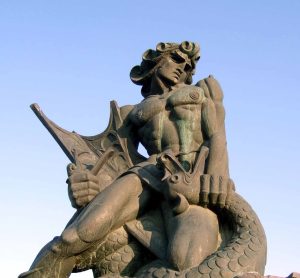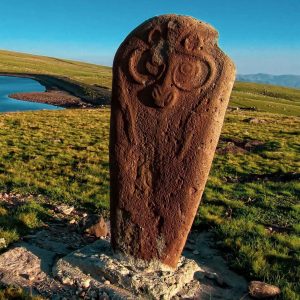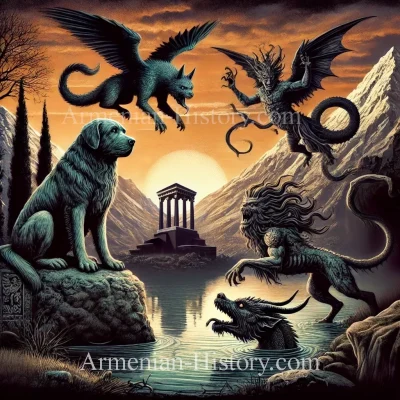Armenian mythology is a rich tapestry of gods, heroes, and mythical creatures that have shaped the cultural heritage of the Armenian people. These mythical beings, with their extraordinary powers and symbolism, continue to inspire stories and legends passed down through generations. This page will take you on a journey through some of the most fascinating mythical creatures in Armenian mythology, examining their roles, symbolism, and influence on the cultural landscape of Armenia
Aralezs (Aralezner)

Aralezs are among the oldest deities in Armenian mythology, often depicted as dog-like creatures with the miraculous ability to revive the fallen by licking their wounds. Believed to inhabit the peaks of sacred mountains, these gods were revered as symbols of healing and resurrection. Armenian warriors would call upon the Aralezs for protection and guidance before going into battle, and legends claim that the bravest soldiers were sometimes brought back to life by these celestial beings.
Vishaps (Dragons)
Vishaps, the Armenian dragons, are prominent figures in Armenian folklore. These serpent-like creatures dwell in mountains, lakes, and clouds, and are capable of causing floods and storms. Vishaps symbolize both destruction and guardianship, depending on the story. Some legends depict Vishaps as protectors of treasure and knowledge, while others cast them as fearsome adversaries, often defeated by heroes like Vahagn, the god of war and thunder.

Azhdahak (The Great Serpent)
Azhdahak is a mythical serpent or dragon figure in Armenian mythology, often seen as a symbol of chaos and darkness. Legends tell of a great battle between Azhdahak and the Armenian god Vahagn, in which Vahagn triumphs over the serpent, symbolizing the victory of light and order over darkness and chaos.
Dragons, similar to Armenian Vishaps, also appear in many other cultures’ mythologies around the world. Their origins and symbolism differ across regions, making them one of the most universally recognized mythical creatures.
Vishapakar (Vishap Stones)
Vishapakar, also known as “dragon stones,” are ancient monolithic stones found in Armenia, often associated with the veneration of Vishaps. These stones are typically carved with depictions of fish, serpents, or other animals, symbolizing water sources and fertility. Vishapakars were placed near springs or water sources, as they were believed to have protective powers and were linked to the worship of Vishaps.

Vishapakars, dating back to the Bronze Age, serve as a testament to the ancient Armenian people’s connection with nature and their belief in the supernatural powers of Vishaps. These mysterious stones remain an important part of Armenia’s archaeological heritage and are a physical link to the mythical creatures of Armenian folklore.

Devs
n Armenian mythology, Devs (or Divs) are malevolent supernatural beings often associated with chaos, darkness, and destruction. Their origins are deeply tied to ancient Indo-European beliefs and they are depicted as antagonists in various myths. In Zoroastrian-influenced Armenian tales, Devs are seen as demons or dark spirits that oppose the divine order and are often combated by gods or heroes. They are similar to other demon-like figures in Persian and Mesopotamian mythologies, playing a role as destructive forces in contrast to gods or benevolent beings like the Aralez or Vishaps.
Devs are often portrayed as living in remote or inaccessible places, such as mountains or caves, and their stories reflect the struggle between good and evil, with them typically being defeated by gods or divine heroes, such as Vahagn in Armenian legends. This duality of good versus evil is a key theme in many Armenian myths, where the forces of light, represented by gods, heroes, or benevolent spirits, battle these chaotic entities.
In a broader cultural sense, the Devs embody fear of the unknown, nature’s wrath, and the destructive aspects of life that ancient Armenians sought to explain through their myths.
Nhangs (Water Creatures)
Nhangs are shape-shifting water spirits that are part of Armenian mythology. These creatures are said to dwell in rivers, lakes, and seas, with the ability to transform into a variety of forms, including serpents, sea creatures, and even humans. In some legends, Nhangs are depicted as dangerous beings capable of drowning people, while in others, they possess healing and protective qualities, depending on their interaction with humans.
Pahapan (Guardians)
Pahapan, meaning “guardian,” is a type of protective spirit in Armenian folklore. These creatures are believed to watch over specific locations, such as sacred sites, forests, and rivers. Pahapan are seen as benevolent beings who protect against evil forces and maintain the balance of nature.
Conclusion: The Legacy of Armenian Mythical Creatures

Armenian mythology is rich with mythical creatures and epic heroes that embody the forces of nature, morality, and the eternal battle between good and evil. These creatures, whether they are revered as protectors or feared as destroyers, continue to hold a significant place in Armenian cultural heritage and folklore. Understanding these mythical beings offers insight into the values, fears, and hopes of the ancient Armenian people, connecting us to a profound and ancient worldview.




